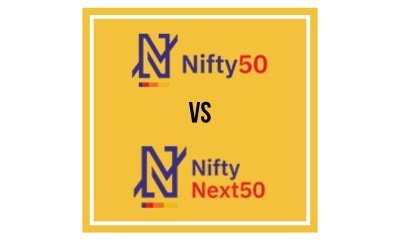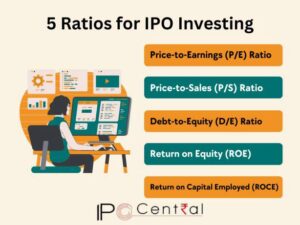
Market indices are like barometers that track the market’s performance. They are hypothetical portfolios that represent a segment of the financial market. Nifty or Nifty50, is a leading market index in India. It comprises the stocks of the 50 largest large-cap companies from diversified sectors.
Nifty50 serves as a benchmark for the Indian equity market. If the underlying stocks of the index go up, the value of the index also increases. Conversely, if the stocks’ prices decline, the index will fall too.
Nifty NEXT 50 is another market index that tracks a broader market, comprising the second 50 large-cap stocks in terms of free-float market capitalisation value.
This article provides insights on Nifty50 and Nifty Next 50, their significance, and their roles in tracking the performance of the Indian stock market.
What is Nifty50?
Nifty50 is a primary market index of the Indian stock market. Nifty stands for National Stock Exchange (NSE) Fifty. It comprises the top 50 largest company stocks on NSE based on their free-float market capitalisation.
Eligibility Criteria for Nifty50
Stocks are included based on their trading volume and free-float market capital—the current value of all the actively traded shares. Companies have to fulfil specific criteria to get included in the Nifty50.
- The company must have a listing history of at least 6 months on NSE.
- The stocks should have high liquidity as measured by impact costs. The impact cost is the price of the share at which it trades relative to the index. Stocks with impact costs not exceeding 0.5% for 6 months are only considered.
- The trading frequency of the stock should be 100% for 6 months.
- The company’s market capitalisation should be at least 1.5x the market capitalisation of the smallest company in the index.
- A minimum of 10% free float is required for inclusion, ensuring sufficient liquidity for investors.
Nifty50 is rebalanced every 6 months based on the above criteria.
How is Nifty50 Computed?
The Nifty50 is calculated using the free float formula.
Index value= Current Market Value / (1000 * Base Market Capital)
- Nifty is calculated on a base value of 1000.
- The base period for the Nifty50 index is 3rd November 1995 and base capital stands at Rs. 2.06 trillion
What is Nifty Next 50?
Nifty Next 50 is constructed after removing the first 50 stocks from the Nifty100. It tracks a broader market. These stocks have the potential to get included in the Nifty50 in the future. These are also the next largest companies in terms of free-float market capitalisation.
Eligibility Criteria for Nifty Next 50 Stocks
- Nifty Next 50 consists of 50 stocks from Nifty100, after excluding the stocks included in Nifty50.
- The cumulative weight of stocks that are not available for F&O trading is capped at 15%.
- The weightage of non-F&O trading stocks is capped at 4.5%.
Like Nifty50, Nifty Next 50 is also recalibrated every 6 months.
How Is Nifty Next 50 Computed?
The formula to calculate Nifty Next 50 is the same as Nifty50.
Which is,
Index value= Current Market Value / (1000 * Base Market Capital)
Nifty50 vs Nifty Next 50: Differences
Nifty50 and Nifty Next 50 both comprise 50 stocks. Although they fall into the category of large-cap indices, they are comparatively different. Here is an analysis of Nifty50 vs Nifty Next 50.
| Nifty50 | Nifty Next 50 | |
| Constituents | Nifty50 represents the top 50 companies based on their free float market capitalisation | Nifty Next 50 represents stocks of the next 50 large-cap companies |
| Diversification | As of 30 November 2022, Nifty50 had stocks from 14 sectors | Nifty Next 50 had stocks from 16 companies during the same period |
| 5-year Absolute Returns | 74.25% (As of 22nd June 2023) | 52.29% (As of 22nd June 2023) |
| Standard Deviation | 23.7 (updated of 6th June 2023) | 26.7 (updated of 6th June 2023) |
Nifty50 vs. Nifty Next 50: Which Is Better?
Although both indices track large-cap stocks, the Nifty Next 50 is slightly more volatile than the Nifty50. Nifty50 offers investment options in large-cap companies that offer better returns during a bullish market. Conversely, the Nifty Next 50 is more diversified, containing stocks of emerging blue-chip companies with significant growth potential. Ideally, one should spread their corpus between Nifty50 and Nifty Next 50 for better risk-adjusted returns.
Final Words Nifty50 and Nifty Next 50 are both major market indices. However, before investing in any fund, one should check the goals, investment horizon, and risk tolerance levels to make an informed decision.
- SEO Powered Content & PR Distribution. Get Amplified Today.
- PlatoData.Network Vertical Generative Ai. Empower Yourself. Access Here.
- PlatoAiStream. Web3 Intelligence. Knowledge Amplified. Access Here.
- PlatoESG. Automotive / EVs, Carbon, CleanTech, Energy, Environment, Solar, Waste Management. Access Here.
- BlockOffsets. Modernizing Environmental Offset Ownership. Access Here.
- Source: https://ipocentral.in/nifty50-vs-nifty-next-50-which-index-is-better/
- :is
- :not
- $UP
- 1
- 14
- 15%
- 16
- 2022
- 2023
- 250
- 30
- 300
- 3rd
- 50
- 6th
- 7
- 90
- a
- above
- Absolute
- actively
- After
- All
- also
- Although
- an
- analysis
- and
- Another
- any
- ARE
- article
- AS
- At
- available
- base
- based
- BE
- before
- Benchmark
- Better
- between
- blue-chip
- both
- broader
- Bullish
- by
- calculate
- calculated
- capital
- Capitalisation
- Category
- central
- check
- Companies
- company
- Company’s
- comparatively
- comprises
- comprising
- considered
- consists
- conversely
- Cost
- Costs
- criteria
- Current
- decision
- Decline
- different
- diversified
- during
- emerging
- ensuring
- equity
- Every
- exchange
- excluding
- Fall
- financial
- Financial Market
- First
- Float
- For
- For Investors
- formula
- Free
- Frequency
- from
- fund
- future
- get
- Go
- Goals
- Growth
- growth potential
- had
- Have
- here
- High
- history
- horizon
- However
- HTTPS
- ideally
- if
- Impact
- in
- included
- inclusion
- Increases
- index
- india
- Indian
- Indices
- informed
- insights
- into
- investing
- investment
- Investors
- IPO
- IT
- jpg
- june
- largest
- leading
- least
- levels
- like
- Liquidity
- listing
- major
- make
- Market
- Market capitalisation
- market value
- measured
- minimum
- months
- more
- must
- National
- next
- Nifty
- November
- of
- offer
- Offers
- on
- ONE
- only
- Options
- or
- performance
- period
- plato
- Plato Data Intelligence
- PlatoData
- portfolios
- potential
- price
- Prices
- primary
- provides
- relative
- removing
- represent
- represents
- required
- returns
- Risk
- risk-adjusted
- roles
- same
- Second
- Sectors
- segment
- serves
- Share
- Shares
- should
- significance
- significant
- specific
- spread
- stands
- stock
- Stock Exchange
- stock market
- Stocks
- sufficient
- terms
- than
- that
- The
- The Future
- their
- These
- they
- to
- tolerance
- too
- top
- track
- Tracking
- traded
- trades
- Trading
- trading volume
- underlying
- updated
- using
- value
- volatile
- volume
- vs
- weight
- which
- will
- with
- zephyrnet











